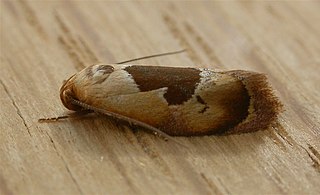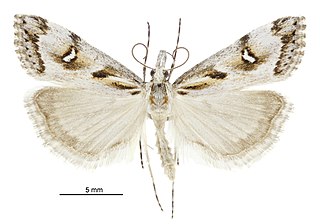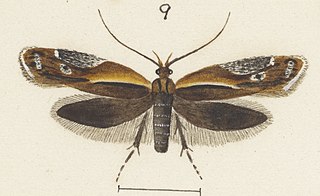
Hoplomorpha camelaea is a moth in the family Oecophoridae first described by Edward Meyrick in 1888. It is found in Australia, where it has been recorded from Victoria, Queensland, New South Wales and the Australian Capital Territory.

Gadira leucophthalma, the beaked moss moth, is a moth in the family Crambidae. It is endemic to New Zealand. It is found in the south eastern side of the South Island down to Banks Peninsula. G. leucophthalma inhabits the foredunes of coastal areas. The larval host is unknown but it has been hypothesised that the larvae feed on moss. The adult moths are day flying although some specimens have been trapped at night via light traps. Adults are commonly on the wing from March to April. This species has been classified as Nationally Vulnerable by the Department of Conservation.

Pyrgotis transfixa is a species of moth of the family Tortricidae. It is endemic to New Zealand. It is classified as "At Risk, Naturally Uncommon" by the Department of Conservation.
Dichomeris procyphodes is a moth in the family Gelechiidae. It was described by Edward Meyrick in 1922. It is found in Amazonas, Brazil.
Dichomeris stratigera is a moth in the family Gelechiidae. It was described by Edward Meyrick in 1922. It is found in Amazonas, Brazil.
Dichomeris oceanis is a moth in the family Gelechiidae. It was described by Edward Meyrick in 1920. It is found in south-eastern Siberia, Japan, China, Korea and Taiwan.
Dichomeris argentaria is a species of moth in the family Gelechiidae. It was described by Edward Meyrick in 1913. It is found in Mpumalanga, South Africa.
Dichomeris citharista is a moth in the family Gelechiidae. It was described by Edward Meyrick in 1913. It is found in southern India.
Dichomeris deltaspis is a moth in the family Gelechiidae. It was described by Edward Meyrick in 1905. It is found in Sri Lanka. The Global Lepidoptera Names Index has this species as a synonym of Dichomeris bisignella.
Dichomeris zygophorus is a moth in the family Gelechiidae. It was described by Edward Meyrick in 1904. It is found in Australia, where it has been recorded from Queensland.
Ardozyga chenias is a species of moth in the family Gelechiidae. It was described by Edward Meyrick in 1904. It is found in Australia, where it has been recorded from New South Wales and Victoria.
Ardozyga odorifera is a species of moth in the family Gelechiidae. It was described by Edward Meyrick in 1904. It is found in Australia, where it has been recorded from New South Wales and Queensland.
Charistica ioploca is a moth in the family Gelechiidae. It was described by Edward Meyrick in 1922. It is found in Amazonas, Brazil.
Pyncostola iospila is a moth of the family Gelechiidae. It was described by Edward Meyrick in 1909. It is found in Namibia and South Africa, where it has been recorded from the Northern Cape and Gauteng.
Stenoma nebrita is a moth of the family Depressariidae. It is found in Panama, Costa Rica and Guyana.
Eclecta is a monotypic moth genus in the family Depressariidae. Its only species, Eclecta aurorella, has been found in the Australian state of New South Wales. Both the genus and species were first described by Edward Meyrick in 1883.

Eutorna caryochroa is a species of moth in the family Depressariidae. It was described by Edward Meyrick in 1889 and is endemic to New Zealand. This species is found in both the North and South Islands. The larvae of this species are leaf miners and prefer damp grassland habitat. The adults are on the wing in December and January. They are day flying moths, they frequent forest and scrub, and have a habit of basking on leaves in the sunshine. They have been collected by beating shrubbery.
Anchinia oenochares is a moth in the family Depressariidae. It was described by Edward Meyrick in 1924. It is found in South Africa and Zimbabwe.

Tingena eumenopa is a species of moth in the family Oecophoridae. It is endemic to New Zealand and found in the North and South Islands. The adults have been found amongst tree ferns and are on the wing in December.

Tingena oxyina is a species of moth in the family Oecophoridae. It is endemic to New Zealand and has been observed in the Otago region. This species inhabits native beech forest at altitudes of between 1000 - 3000 ft. Adults of this species are on the wing in January.





